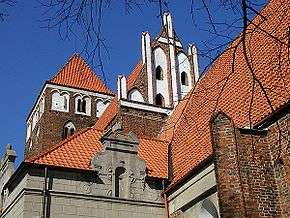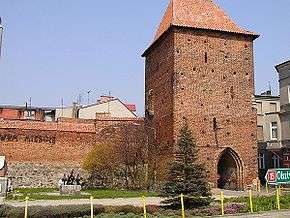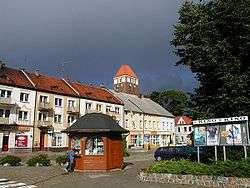Nowe Miasto Lubawskie
| Nowe Miasto Lubawskie | ||
|---|---|---|
|
Market Square | ||
| ||
 Nowe Miasto Lubawskie | ||
| Coordinates: 53°25′N 19°35′E / 53.417°N 19.583°E | ||
| Country |
| |
| Voivodeship | Warmian-Masurian | |
| County | Nowe Miasto | |
| Gmina | Nowe Miasto Lubawskie (urban gmina) | |
| Established | 1325 | |
| Town rights | 1325 | |
| Government | ||
| • Mayor | Józef Blank | |
| Area | ||
| • Total | 11.61 km2 (4.48 sq mi) | |
| Elevation | 82 m (269 ft) | |
| Population (2011[1]) | ||
| • Total | 11,162 | |
| • Density | 960/km2 (2,500/sq mi) | |
| Time zone | CET (UTC+1) | |
| • Summer (DST) | CEST (UTC+2) | |
| Postal code | 13-300 | |
| Area code(s) | +48 56 | |
| Car plates | NNM | |
| Website | www.umnowemiasto.pl | |
Nowe Miasto Lubawskie [ˈnɔvɛ ˈmʲastɔ luˈbafskʲɛ] (German: ![]() Neumark in Westpreußen ) is a town in Poland, situated at river Drwęca. The population is 11,162 (2011). Nowe Miasto Lubawskie is the capital of Nowe Miasto County (Polish: powiat nowomiejski) and was assigned to the Warmian-Masurian Voivodeship in 1999.
Neumark in Westpreußen ) is a town in Poland, situated at river Drwęca. The population is 11,162 (2011). Nowe Miasto Lubawskie is the capital of Nowe Miasto County (Polish: powiat nowomiejski) and was assigned to the Warmian-Masurian Voivodeship in 1999.
Geographical location
Nowe Miasto Lubawskie is located on the r.h.s of the upper course of river Drwęca in Gdańsk Pomerania, on a high ground in the valley of the Drwęca, about 15 kilometers south-west of the town of Lubawa, 70 kilometers south-west of the town of Olsztyn and 115 kilometers south-east of the regional center of Gdańsk.



History
The town's official webpage connects its early history with settlement by early Slavic peoples, and later settlement by Old Prussians who were conquered by Polish ruler Bolesław Krzywousty.[2] In 1310 the Teutonic Order acquired the region of Gdańsk Pomerania and Otto von Luttenberg, Komtur of Culm, founded the settlement in 1325. It was known under the names Nuwenmarkt, Novum Forum and Nowy Targ.[2] Between 1334–43 it was the seat of a Vogt of the Teutonic Order. It adopted Kulm law in 1353. In Polish–Teutonic War of 1410 the town briefly became part of Poland due to result of local fighting, and remained so until the 1411 Peace Treaty. In 1454, the city joined the Prussian Confederation, an association of cities and gentry that opposed the policies of the Order and wanted the region to become part of Poland.

After the Second Peace of Thorn (1466) the town, as part of the province of Royal Prussia became part of Kingdom of Poland, where it remained until 1772. During the Reformation, in 1581 the parish church, which is almost as old as the town itself, became evangelical. In the 18th century the town was still surrounded by a town wall and by a rampart, and the parish church was Catholic.[3] A Protestant church was built in 1824.
In the First Partition of Poland in 1772 Gdańsk Pomerania was incorporated into the Kingdom of Prussia, and Neumark belonged now to the newly formed province of West Prussia.
At the end of the 19th century, the town was capital of Landkreis Löbau in the Prussian administrative district of Regierungsbezirk Marienwerder in West Prussia, where it remained until 1919. It had a Lutheran and a Catholic church, a Progymnasium, a court, a steam mill with grain trading, and (as of 1885) 2,678 inhabitants. The monastery Maria-Lonk was nearby. Around 1908 the town also had a dairy, an electric power plant, three sawmills and brickwork.[4]
Until 1920 Neumark belonged to Kreis Löbau in the administrative district of Regierungsbezirk Marienwerder in the German Province of West Prussia.
When after World War I the Treaty of Versailles became effective in January 1920, and the Polish Corridor was created the town was incorporated into the Second Polish Republic, close to the border with German East Prussia. The city webpage notes 19 January 1920 as the "return of the city to the motherland".[5] During the Second Polish Republic Nowe Miasto Lubawskie was the capital of Nowe Miasto County (Polish: powiat nowomiejski) in the Polish Pomeranian Voivodeship.
During the German Invasion of Poland in 1939 the town and the local area were occupied on 3 September. Afterwards 2,500 civilians were mass murdered in actions carried out by the SS and units made up from German minority's militia, the Selbstschutz.[2] From 26 October 1939 to 1945 Neumark belonged to Landkreis Löbau/Neumark in the province of Reichsgau Danzig-West Prussia.
On 21 January 1945 the town was captured by the Red Army. After the war the town returned to Poland which by then had become the People's Republic of Poland.
Number of inhabitants by year
| Year | Number[3][4][6][7] |
|---|---|
| 1789 | 809 |
| 1831 | 1,188 |
| 1875 | 2,371 |
| 1880 | 2,742 |
| 1885 | 2,678 |
| 1890 | 2,723 |
| 1905 | 3,800 |
| 1910 | 4,144 |
| 1921 | 3,721 |
| 1943 | 4,884 |
| 2006 | 11,036 |
| 2011 | 11,162 |
Famous people
- Zyta Gilowska, Polish economist and politician
- Joseph Newmark (1799–1881)
- Nikolaus von Vormann, Wehrmacht general.
International relations
Twin towns — Sister cities
Nowe Miasto Lubawskie is twinned with:
-
 Hude, Germany
Hude, Germany -
 Šalčininkai, Lithuania
Šalčininkai, Lithuania
References
- ↑ Demographic Yearbook of Poland 2012
- 1 2 3 O Mieście Urząd Nowego Miasta Lubawskiego
- 1 2 Johann Friedrich Goldbeck: Vollständige Topographie des Königreichs Preußen. Teil II, Marienwerder 1789, pp. 45–46, no. 5.]
- 1 2 Meyers Großes Konversations-Lexikon, 6th edition, Vol. 14, Leipzig and Vienna 1908, p. 565–566, no. 1).
- ↑ O Mieście Urząd Nowego Miasta Lubawskiego "Nowe Miasto Lubawskie, podobnie jak całe Prusy Królewskie, zostało zagarnięte przez państwo pruskie w wyniku traktatów rozbiorowych z 1772 roku, a powróciło do Macierzy dopiero 19 stycznia 1920 roku"
- ↑ Michael Rademacher: Deutsche Verwaltungsgeschichte Provinz Westpreußen, Kreis Löbau/Neumark (2006).
- ↑ August Eduard Preuß: Preußische Landes- und Volkskunde. Königsberg 1835, p. 436, no. 43.
External links
| Wikimedia Commons has media related to Nowe Miasto Lubawskie. |
- (Polish) Tygodnik Internetowy - weekly alternative newspaper online features top news stories, local information for Nowe Miasto area.
- (Polish) Official town website
- Old photo of towns square and church
- Images of Nowe Miasto Lubawskie
Coordinates: 53°25′N 19°36′E / 53.417°N 19.600°E


